Exhibition Overview
In China, paintings that tell stories serve as powerful vehicles to promote political agendas, endorse cultural values, or express personal thoughts. With masterpieces dating from the fourth century, narrative is the earliest established genre in Chinese painting. This exhibition is the first at The Met to explore the various ways in which Chinese artists have gone beyond mere illustration to convey multiple layers of meaning.
Displaying works from the 12th century to the present, this exhibition introduces three distinct modes of pictorial storytelling: multipart illustrations presented in long handscrolls, often punctuated with passages of text; single iconic scenes that evoke an entire story; and generic landscapes or flower-and-bird paintings that acquire narrative significance through the artist's inscription. The exhibition is further organized by theme: historical events, seasonal progression, warfare, journeys, Buddhist and Confucian values, and family and friendship. One special gallery focuses on a grandiose military narrative—that of China's annexation of East Turkestan in the 1750s. The installation, a collaboration among three Museum departments, features a suite of European engravings alongside Chinese weaponry and a painting to show how an emperor exploited art for his own aggrandizement.
Contemporary Chinese artists have continued the narrative tradition with an expanded repertoire of subjects and approaches. The examples on display range from reflections on the creative process to critiques of modern technology and government policies. Together, the approximately 60 pictorial works and 30 decorative art objects, most from The Met collection, present a comprehensive view of the narrative genre, demonstrating its expressive versatility and continuing relevance.
Show and Tell: Exploring Storytelling in Chinese Painting
Fig. 1. Unidentified artist after Song Academy painter. Eighteen Songs of a Nomad Flute: The Story of Lady Wenji (detail), early 15th century. Chinese, Ming dynasty (1368–1644). Handscroll; ink, color, and gold on silk, 11 1/4 in. x 39 ft. 3 in. (28.6 x 1196.3 cm). The Metropolitan Museum of Art, New York, Ex coll.: C. C. Wang Family, Gift of The Dillon Fund, 1973 (1973.120.3)
The genre of narrative painting in China reached full maturity as early as the fourth century and continues to thrive today. The exhibition Show and Tell: Stories in Chinese Painting—on view at The Met Fifth Avenue through August 6, 2017—explores how Chinese painters have told stories that promote political and cultural agendas or communicate personal thoughts. Presenting more than 60 paintings and prints dated from the 12th century to the present, this exhibition demonstrates the continuing vitality and relevance of the genre.
Show and Tell is organized into three sections, with each featuring a different type of narrative. The most familiar of these is the long handscroll format used to illustrate a story in multiple scenes. As each of the handscrolls unrolls section by section from right to left, either in a continuous landscape setting or in scenes punctuated by corresponding texts, the viewer is transported through time and space. Measuring more than 39 feet in length, Eighteen Songs of a Nomad Flute: The Story of Lady Wenji (fig. 1) depicts the traumatic experience of Lady Wenji (Cai Yan), who was abducted by Mongolian nomads in 195 A.D. and returned to China 12 years later. The recurring sight of south-flying geese alludes to her homesickness, while intimate scenes of Wenji with her chieftain husband and their children deepen the pathos of the farewell scene as she is forced to leave them behind. Although this work was created in the early 15th century, this historical story resonates deeply with the issues of ethnicity and displacement of our own time.
Fig. 2. Zheng Zhong (Chinese, active ca. 1612–1648). Searching the Mountains for Demons (detail), first half of 17th century. Chinese, late Ming dynasty (1368–1644). Handscroll; ink and color on paper, 10 5/8 in. x 27 ft. 9 1/2 in. (27 x 847.1 cm). The Metropolitan Museum of Art, New York, Purchase, Bequest of Dorothy Graham Bennett, 1991 (1991.14)
Without any explanatory texts, Searching the Mountains for Demons by Zheng Zhong (active ca. 1612–1648) (fig. 2) depicts a demigod and his ghostly entourage ridding the landscape of demonic creatures. The exorcist operation zigzags through a series of vignettes featuring demons in the form of wild beasts or charming women, whose true identities are revealed by their claws and tails. The dynamic composition conveys the frenzied pace of the hunt as disturbing images of violence are balanced by humorous encounters and the exertions of the hunters.
Fig. 3. Liang Kai (Chinese, active early 13th century). Poet Strolling by a Marshy Bank, early 13th century. Chinese, Southern Song dynasty (1127–1279). Fan mounted as an album leaf; ink on silk, 9 x 9 9/16 in. (22.9 x 24.3 cm). The Metropolitan Museum of Art, New York, Bequest of John M. Crawford Jr., 1988 (1989.363.14)
The second type of narrative highlighted in the exhibition relies on a single iconic scene—usually the climax—to evoke an entire story in the viewer's mind. A painting by the monk-artist Liang Kai (active early 13th century) exemplifies this style. In Poet Strolling by a Marshy Bank(fig. 3), a lone figure lingers by a marshy bank under a massive, mist-enshrouded boulder. The work hauntingly depicts the final moments in the life of Qu Yuan (ca. 340–ca. 278 B.C.), a falsely slandered minister who took his own life by drowning in order to prove his devotion to the king, without showing any other biographical detail. The looming rock, a metaphor for the psychological weight sustained by the man below, is key to identifying the subject matter.
Fig. 4. Hongli (Qianlong Emperor, 1711–1799; r. 1736–95). Deer Antlers, dated 1762. One of two handscrolls; ink and color on paper, 9 3/4 x 81 1/4 in. (24.8 x 206.4 cm). The Metropolitan Museum of Art, New York, John Stewart Kennedy Fund, 1913 (13.220.127b)
The third type of storytelling is represented by landscapes, still lifes, and flower-and-bird paintings that contain no narrative imagery but tell stories in their appended inscriptions. A typical example is a painting of deer antlers (fig. 4) by Emperor Qianlong (r. 1736–95). An otherwise simple still life, the picture is followed by the emperor's long inscription that relates when and where the deer was hunted down by his grandfather, the Kangxi Emperor, and reflects upon Kangxi's prowess and the martial values in his Manchu tradition. This type of storytelling is an important and distinctively Chinese practice, one that has never been recognized in exhibitions exploring narrative subjects.
Fig. 5. Wang Jun (Chinese, 1816–after 1883). The Shrine in Honor of Ruan Yuan, from the album Ten Sites Associated with Ruan Yuan, dated 1883. Chinese, Qing dynasty (1644–1911). One painting from an album of 10 paintings; ink and color on paper, each image: 11 in. x 13 1/4 in. (27.9 x 33.7 cm). The Metropolitan Museum of Art, New York, Gift of Julia and John Curtis, 2015 (2015.784.10)
Most of the objects in the exhibition are taken from The Met collection; some are new acquisitions on view for the first time, while others have not been seen for many years. A few works that had been shown in partial view in past shows now enjoy a complete display, such as Wang Jun's (1816–after 1883) album on select sites in Yangzhou and Hangzhou (fig. 5), which serves as a pictorial biography of the eminent scholar-official Ruan Yuan (1764–1849). This new display of all 10 pictures in the album, rearranged in chronological order, enables a comprehensive and evolving view of the man's life.
Fig. 6. Jacques Philippe Le Bas (French, 1707–1783), after Giuseppe Castiglione (Italian, 1688–1766). The Lifting of the Siege at the Black River Camp (detail), plate seven from The Conquests of the Emperor of China (Les Conquêtes de l'Empereur de la Chine), 1771. Etching and engraving, Plate: 22 5/8 x 36 11/16 in. (57.5 x 93.2 cm). The Metropolitan Museum of Art, New York, Harris Brisbane Dick Fund, 1945 (45.100.7)
Further showcasing The Met's ability to draw on its own holdings for a multicultural exhibition is a gallery on military narrative, the objects of which represent the collaboration of three curatorial departments. The subject of the gallery is Emperor Qianlong's East Turkestan campaign from 1755 to 1759, which ended with the annexation of Xinjiang (New Territories). The centerpiece, from the Department of Drawings and Prints, is a suite of sixteen copperplate engravings that illustrate ten battles and six ceremonies (fig. 6). Designed in the Western naturalistic style by European missionary-artists at Qianlong's court, more than 200 sets of prints were produced at the imperial workshop of Louis XV (r. 1715–74) in Paris.
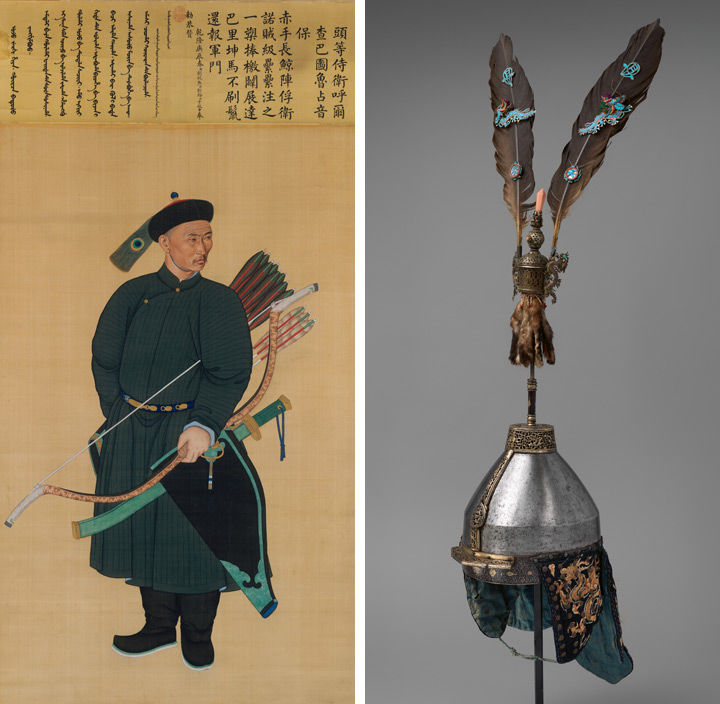
Left: Fig. 7. Unidentified artist. Portrait of the Imperial Bodyguard Zhanyinbao, dated 1760. Chinese, Qing dynasty (1644–1911). Hanging scroll; ink and color on silk, Painting and inscription: 74 1/4 x 37 7/16 in. (188.6 x 95.1 cm). The Metropolitan Museum of Art, New York, Purchase, The Dillon Fund, 1986 (1986.206). Right: Fig. 8. Helmet with feather crest, 17th–18th century. Chinese, Qing dynasty (1644–1911). Helmet: steel, gold, silk; Crest: eagle feathers, kingfisher feathers, paper, turquoise, coral, pearls, marten fur, silk, copper alloy, silver, Helmet: H. including nape defense: 20 3/4 in. (52.7 cm); H. excluding nape defense: 11 1/4 in. (28.6 cm); W. 9 in. (22.9 cm); D. 10 1/4 in. (26 cm). The Metropolitan Museum of Art, New York, Bequest of George C. Stone, 1935 (36.25.2c–e, .7a)
The large full-length portrait of a general (fig. 7), one of 100 commissioned by Qianlong for those who made significant contributions to the campaign, belongs to the Department of Asian Art. A dozen 18th-century Chinese weapons and horse fittings from the Department of Arms and Armor, selected by Curator Donald LaRocca, evoke a physical sense of warfare. It is notable how close some pieces look to those represented in the prints and the portrait. The helmet with a feather crest for a high-ranking military officer (fig. 8), for instance, is worn by the commander on horseback in the center foreground of the print hung on the opposite wall (fig. 6).
In addition, there are works on view by contemporary artists addressing current issues raised by technological advancements and government land policy, or revealing personal creative processes—subjects not in the classical repertory. The exhibition presents a most comprehensive view of Chinese pictorial storytelling with many illuminating and engaging samples.
Related Links
Show and Tell: Stories in Chinese Painting, on view at The Met Fifth Avenue through August 6, 2017
Show and Tell: Stories in Chinese Painting, on view at The Met Fifth Avenue through August 6, 2017
Now at The Met: "A Reunion after Sixty Years: The Lin Yutang Family Collection" (June 26, 2015)
82nd & Fifth: "Metaphorical" by Shi-yee Liu
Liu, Shi-yee. "Containing the West in the Manchu Realm? Emperor Qianlong's Deer-Antler Scrolls." Orientations 46, no. 6 (September 2015): 58–69.
Liu, Shi-yee. "'Show and Tell': The Art of Storytelling in Chinese Painting." Orientations 47, no. 8 (November/December 2016): 44–53.

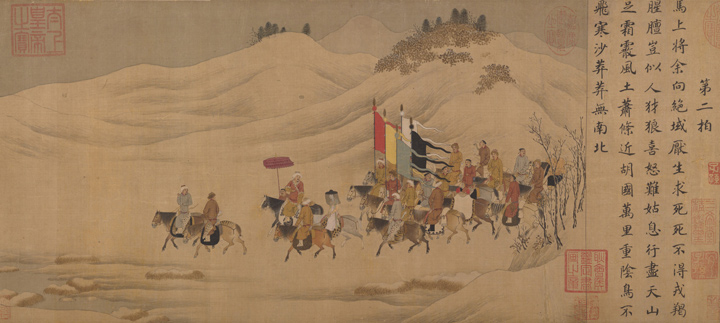

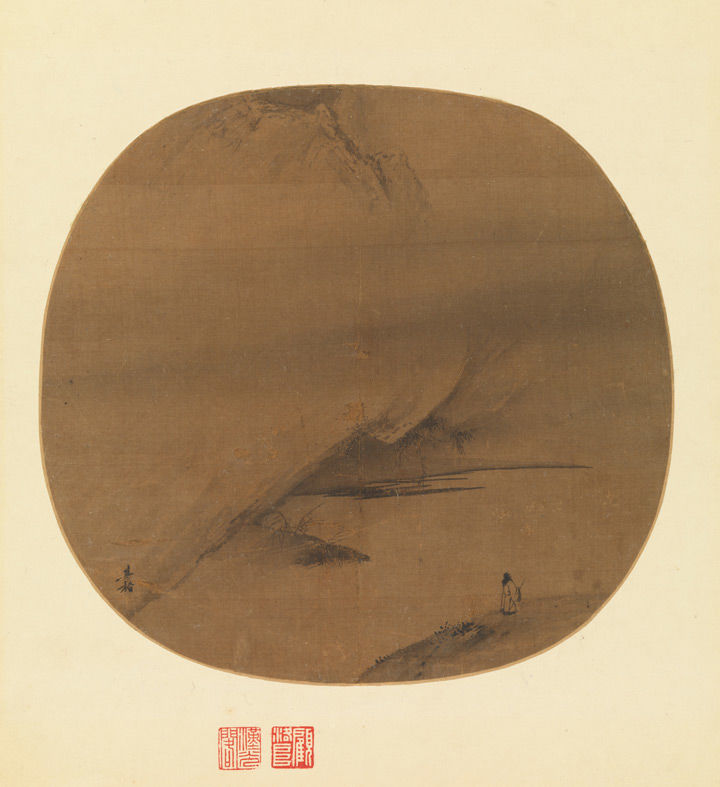

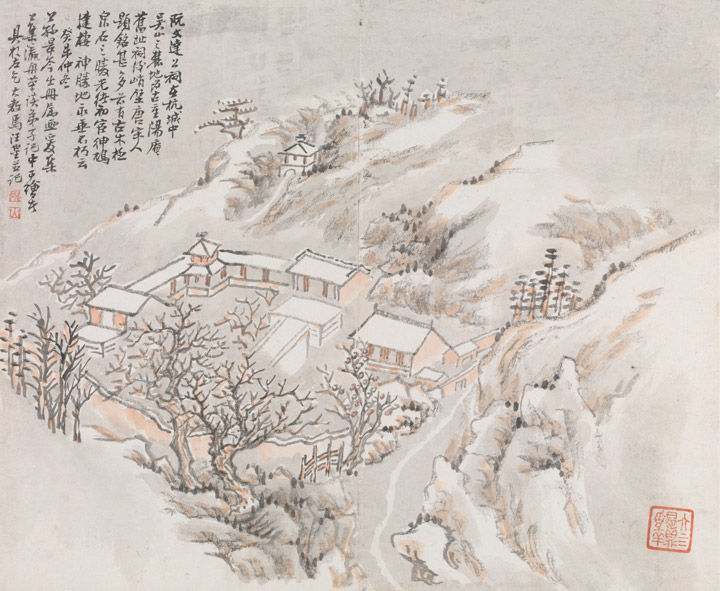
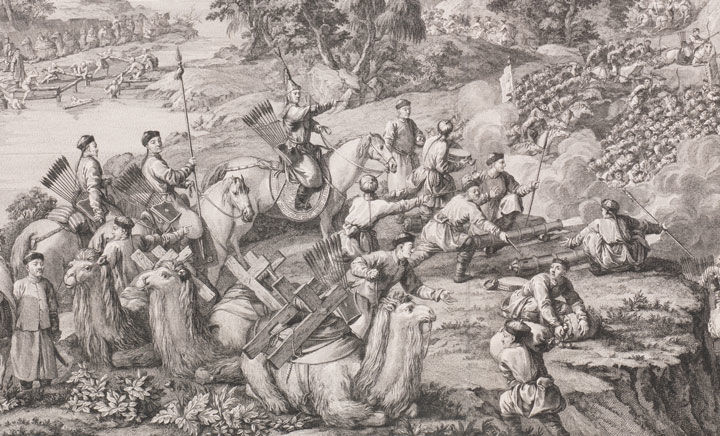
1 comment:
Genuine Love Spell Caster Dr.Obodo. Spells to attract love, Stop divorce, Marriage Spells, Bring lost love, Money and wealthy spells, Protection spells, fertility spell ..Contact Info
E-mail: templeofanswer@hotmail.co.uk
Call,Viber and whatsapp +2348155425481
Post a Comment